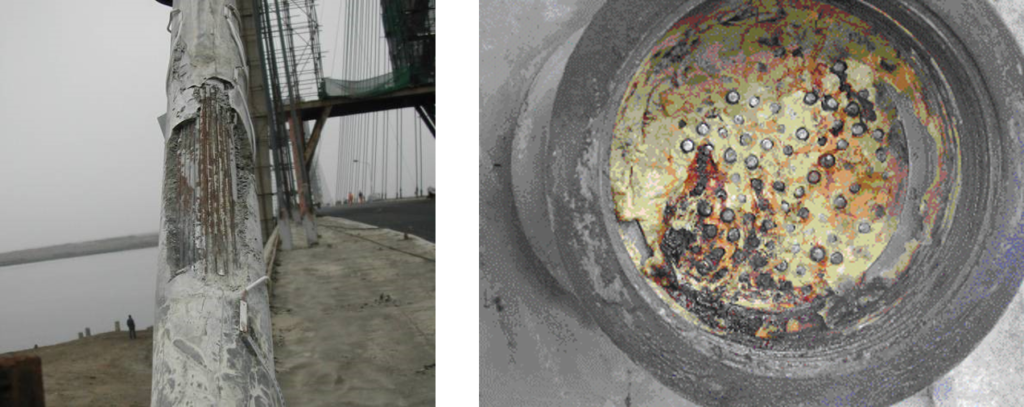SMC Benchmark Problems for Condition Assessment and Damage Detection
A full-scale bridge benchmark problem with several observed damage patterns was organized by the Center of Structural Monitoring and Control (SMC) at the Harbin Institute of Technology, China. Detailed investigation of this problem has been published in the Journal of Structural Control and Health Monitoring named “SMC Structural Health Monitoring Benchmark Problem Using Monitored Data from an Actual Cable-stayed Bridge”.
The actual damage patterns of the full-scale bridge included damage of stay cables, as shown in Figure below, and the damage at the girder. For blind test, the position of the damage at the girder is not provided here and should be localized by the approach proposed by the participants of this Benchmark problem.

Objectives of Benchmark Problems
A structural health monitoring (SHM) system provides an efficient way to diagnose the condition of critical and large-scale structures such as long-span bridges. With the development of SHM techniques, numerous condition assessment and damage diagnosis methods have been developed to monitor the evolution of deterioration and long-term structural performance of such structures, and to conduct rapid damage and post-disaster assessments. However, the condition assessment and damage detection methods described in the literatures are usually validated by numerical simulation and/or laboratory test of small-scale structures with assumed deterioration models and artificial damage, which makes the comparison of different methods invalid and unconvincing to a certain extent. The Center of Structural Monitoring and Control (SMC) organized benchmark problems for an actual cable-stayed bridge, aiming to provide a convincing platform for researchers to conduct an assessment of the stay cables of the bridge and validate their damage detection approaches based on the monitoring data from the bridge. Such studies are important for successful development of structural condition assessment and damage detection algorithms, and resolve issues that are critical in practical applications of structural health monitoring techniques.
Benchmark Problem-Introduction
An actual cable-stayed bridge with an implemented SHM system, which monitors vehicle loads, cable stresses, girder strains, accelerations, wind, temperature and humidity, is employed as the benchmark structure. Focusing on two critical and vulnerable components of cable-stayed bridges, two benchmark problems are proposed based on the field monitoring data from the full-scale bridge, i.e., condition assessment of stay cables (Benchmark Problem 1) and damage detection of bridge girders (Benchmark Problem 2).
1. Condition assessment of stay cables
(i) Fatigue life prediction model of parallel wire cables
As far as we know, the stay cables are composed of steel wires. The fatigue properties of corroded steel wires were investigated by conducting experiments. In future assessments, researchers are encouraged to develop fatigue life prediction models for the deteriorated parallel wire cables based on the fatigue properties of the corroded steel wires. The fatigue lives of the tested cables can be used for reference.
(ii) Residual fatigue life assessment of deteriorated cables
The residual fatigue life assessment of deteriorated cables under monitoring cable stress and the fatigue life of cables obtained as described above (i) are other points of interest. The assessment results might yield certain terms for cable replacement maintenance.
2. Damage detection of girder
On August 2008, several damage patterns were detected during an inspection of the bridge. These damage patterns were actual damage patterns, and the measured data can be used to test the ability of various SHM methods to detect, localize and quantify these damage patterns. As stated previously, researchers could devote their efforts to the following problems:
(i) Detecting and localizing the stated damage patterns
Although the frequency changes during the development of damage were significant, researchers could attempt to determine whether the frequency changes were caused by girder damage, environmental variation or other factors. Researchers could also localize the damage by employing the measurement datasets from January and August, 2008.
(ii) Detecting, localizing and quantifying damage development process
Researchers are encouraged to detect the damage’s developmental process, i.e., the processes by which damage patterns 1 and 2 evolved.
After you have downloaded the data, please send us an e-mail to request the password for the data packages.
Please find all data and data manual in Link1 and Link2.
References
[1] Shunlong Li, Hui Li, Yang Liu, Chengming Lan, Wensong Zhou, Jinping Ou. SMC structural health monitoring benchmark problem using monitored data from an actual cable-stayed bridge. Structural Control and Health Monitoring. 2014; 21: 156-172.
[2] Hui Li, Shunlong Li, Jinping Ou, Hongwei Li. Reliability assessment of cable-stayed bridges based on structural health monitoring techniques. Structure and Infrastructure Engineering. 2012; 8(9): 829-845.
[3] Hui Li, Chengming Lan, Yang Ju, Dengsheng Li. Experimental and numerical study of the fatigue properties of corroded parallel wire cables. Journal of Bridge Engineering. 2012; 17(2): 211-220.
[4] Hui Li, Shunlong Li, Jinping Ou, Hongwei Li. Modal identification of bridges under varying environmental conditions: Temperature and wind effects. Structural Control and Health Monitoring. 2010; 17(5): 495-512.
[5] Wensong Zhou, Shunlong Li, Hui Li. Damage detection for SMC benchmark problem: a subspace-based approach. International Journal of Structural Stability and Dynamics. 2016; 16(4): 1640025.
